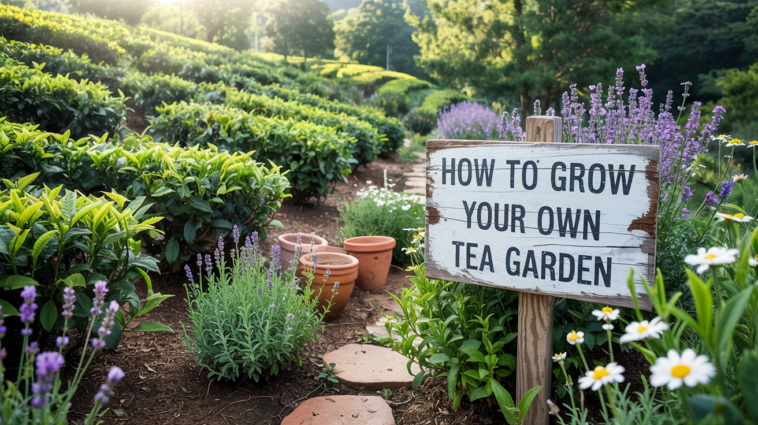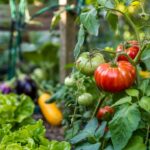There’s something magical about sipping a cup of tea brewed from herbs you’ve nurtured yourself. A tea garden brings beauty, tranquility, and wellness to your space—and growing one doesn’t require acres of land. Whether you have a small balcony, a backyard, or even just a few containers by a sunny window, you can create your own soothing oasis with herbs perfect for steeping.
Over the years, I’ve found that growing my own tea herbs not only ensures fresh, chemical-free ingredients but also adds an inviting aroma and calming energy to my home. Let me walk you through how to grow a thriving tea garden, even in the smallest of spaces.
Choosing the Right Container

If you’re short on space or prefer a tidy setup, growing your tea herbs in containers is ideal. Here’s what to consider:
- Size: Choose pots that are at least 8–12 inches deep to give roots plenty of room. For larger herbs like lemon balm or chamomile, go for a 12–14 inch pot.
- Material: Terracotta, ceramic, or food-safe plastic pots all work well. Just make sure they’re sturdy and UV-resistant.
- Drainage: Good drainage is crucial. Select pots with holes at the bottom, and add a saucer or tray if growing indoors to catch excess water.
Selecting the Best Varieties for Tea
Here are 15 delicious and easy-to-grow herbs perfect for any tea garden, with expanded descriptions to help you choose your favorites:
1. Chamomile (Matricaria chamomilla)
Delicate, daisy-like flowers brew into a calming tea that soothes stress and promotes sleep. Prefers full sun and well-draining soil.
2. Peppermint (Mentha × piperita)
This vigorous grower brings a refreshing flavor and helps with digestion. Best grown in containers to prevent spreading.
3. Lemon Balm (Melissa officinalis)
A gentle lemon-scented herb that eases anxiety and promotes relaxation. Keep it in partial sun and trim regularly.
4. Lavender (Lavandula angustifolia)
More than just beautiful, lavender flowers steep into a fragrant, calming blend that pairs well with other herbs like chamomile.
5. Lemongrass (Cymbopogon citratus)
With tall, graceful blades, lemongrass adds a bright citrusy flavor to tea and is easy to grow in warm, sunny climates.
6. Ginger (Zingiber officinale)
Ginger root brings warmth, spice, and powerful medicinal benefits. It grows well in containers in partial shade with rich, moist soil.
7. Tulsi / Holy Basil (Ocimum tenuiflorum)
An adaptogenic herb known for its ability to reduce stress and boost immunity. Loves heat, full sun, and regular pruning.
8. Rosemary (Rosmarinus officinalis)
Its piney, slightly floral flavor makes a unique tea that supports memory and digestion. Prefers full sun and dry conditions.
9. Fennel (Foeniculum vulgare)
Both the seeds and fronds can be brewed. Fennel tea is sweet, aromatic, and aids in digestion and bloating relief.
10. Calendula (Calendula officinalis)
Sunny orange blossoms with anti-inflammatory properties. Best harvested fresh and steeped for skin and digestive health.
11. Sage (Salvia officinalis)
Earthy, robust, and slightly peppery. Sage tea is rich in antioxidants and supports throat and mouth health.
12. Thyme (Thymus vulgaris)
This herb has antimicrobial benefits and a gentle herbal flavor that pairs well with honey and lemon.
13. Stevia (Stevia rebaudiana)
A natural sweetener that can be dried and added to tea blends in place of sugar.
14. Anise Hyssop (Agastache foeniculum)
Beautiful purple flowers and a sweet, licorice-like flavor. Attracts pollinators and makes a soothing bedtime tea.
15. Catnip (Nepeta cataria)
While cats love it, catnip tea is surprisingly good for humans too—it’s mild, minty, and helps with sleep and digestion.
Planting Process

Starting your tea garden is simple once you’ve gathered your herbs. Here’s how to plant them for the best results:
- Use quality potting soil: A well-draining mix with compost ensures good growth. Avoid heavy garden soil in containers.
- Spacing: Plant each herb in its own container or give at least 6–12 inches between herbs if using raised beds or large planters.
- Sunlight: Most tea herbs prefer full sun (6–8 hours), though some—like mint and lemon balm—do well with partial shade.
- Watering: Keep the soil moist but not soggy. Water when the top inch of soil feels dry, and always allow excess water to drain.
Care and Maintenance
Keeping your tea garden healthy is all about balance. Here’s how to maintain lush, flavorful herbs throughout the seasons:
- Pruning: Regularly pinch back herbs to encourage bushy growth and prevent flowering (which can reduce leaf flavor).
- Fertilizing: Use a diluted organic liquid fertilizer once a month during the growing season. Overfeeding can reduce flavor.
- Pest Management: Keep an eye out for aphids, spider mites, and whiteflies. Neem oil or insecticidal soap works well for treatment.
- Harvesting Leaves and Flowers: Morning is the best time to harvest when essential oils are most concentrated. Use clean scissors and only take up to ⅓ of the plant at a time.
Harvesting and Brewing
Once your herbs are ready, the fun begins. Here’s how to harvest and use them:
- Fresh use: Pick leaves or flowers, rinse gently, and steep in hot (not boiling) water for 5–10 minutes depending on the herb.
- Drying herbs: Tie small bunches upside down in a cool, airy space for a week or two. Store in glass jars away from sunlight.
- Blending: Mix and match! Try chamomile + lavender for relaxation, or peppermint + ginger for digestion.
Final Thoughts
Growing your own tea garden is more than just a hobby—it’s a mindful practice that nurtures your well-being and connects you with the rhythms of nature. With a few pots, some sunshine, and a little patience, you can sip your way through the seasons with herbs that are as fresh and personal as the care you’ve given them.
So why not start today? Pick a few herbs, find a sunny spot, and let your tea garden bloom.


